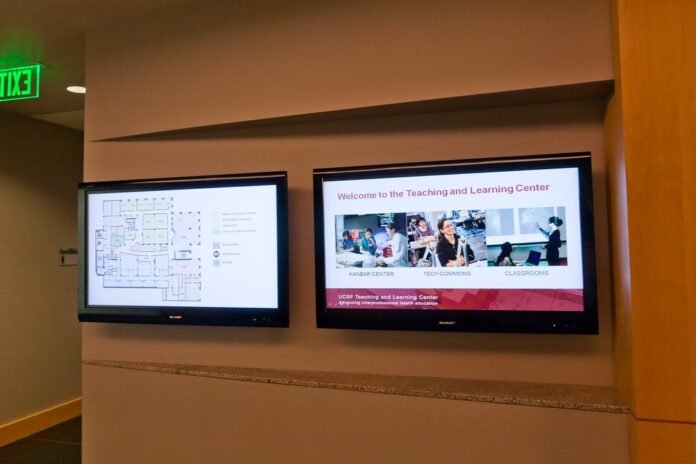In the digital era, effective communication has become a cornerstone of efficient public service. Local Government Areas (LGAs) and public institutions are continually searching for ways to enhance service delivery and engage with the community effectively. One innovation that has been pivotal in transforming public interaction is government digital signage. Here’s how digital solutions are streamlining operations and revolutionising the public sector.
Table of Contents
Enhancing Communication with the Public
Government departments often grapple with the challenge of disseminating important information to the public. Digital signage provides a dynamic platform that can be updated in real-time, ensuring that crucial messages reach the community without delay. With screens strategically located in council buildings, libraries, and public squares, citizens can access up-to-date information with ease.
Interactive Wayfinding and Directories
Navigating government buildings can be an overwhelming experience for many. An intuitive solution comes in the form of interactive digital wayfinding systems. These systems not only direct visitors efficiently but are also accessible for people of different abilities, ensuring inclusivity in public services.
Connecting with the Community through LGA Government Signage
For LGAs, maintaining a consistent line of communication with residents is paramount. LGA & Government signage serves as a versatile tool, offering a platform for everything from community announcements and emergency alerts to promoting local events. This immediacy and visibility foster a sense of community and keeps everyone informed.
Digital Notice Boards for Effective Messaging
Physical notice boards have their limitations, often going unnoticed or becoming outdated. Digital notice boards offer a compelling alternative, capturing the public’s attention with dynamic content and vibrant displays, allowing for instant updates whenever required.
Cost Efficiency and Environmental Consideration
Switching to digital signage reduces the reliance on paper, significantly lowering printing costs and decreasing environmental impact. As the government strives for sustainability, digital signage signifies a forward-thinking approach to conserving resources while still maintaining effective communication.
Resource Allocation and Managing Queues
Effectively managing foot traffic and queues in public offices is crucial for efficient operation. Digital queuing systems inform visitors of wait times and direct them to the correct service points, enhancing the customer service experience and allowing staff to allocate resources more effectively.
Emergency Alerts and Public Warnings
In times of emergency, conveying vital information quickly can save lives. Digital signage stands out for its ability to broadcast instant alerts and safety instructions to the public, ensuring that everyone gets the message when it matters most.
Multilingual Support for Diverse Communities
Australia’s diverse population requires public information to be accessible in multiple languages. Digital signs cater to this need by providing translations and ensuring that every member of the community has access to important notices.
Incorporating Modern Aesthetics
Government institutions often carry a traditional aesthetic, but modern digital signage can infuse public spaces with a contemporary look while delivering essential information. This balance of form and function reflects a modernised public sector that values both utility and design.
Personalising Content Delivery
With smart content management systems, digital signage can personalise the information displayed, catering to different demographics, times of the day, and even local weather conditions, thereby ensuring that the content is relevant to those viewing it.
Boosting Public Participation with Technology
Engaging citizens in government initiatives and services is a constant endeavour. Interactive digital signage encourages public participation by allowing individuals to interact with content, provide feedback, and feel involved in the local governance processes.
Training and Employee Communication
Gone are the days of static training materials and memos. Digital signage in government offices can also be utilised to train employees, display job openings, and communicate HR policies, ensuring that the public sector workforce is always up-to-date and aligned with the institution’s goals.
Extending the Reach Beyond Physical Locations
Government digital signage isn’t restricted to physical offices. With the capability to stream content across various platforms, information can reach a broader audience, expanding beyond the confines of bricks-and-mortar locations.
Case Study: Digital Signage Gold Coast Initiatives
Case studies such as the implementation of digital signage on the Gold Coast showcase the effectiveness of these systems in action. The Gold Coast community benefits from real-time updates, interactive tourist information, and streamlined service provision in public spaces.
Conclusion: The Future is Digital
The future of public service is clearly heading towards a more digital and interconnected approach. With government digital signage leading the charge, the possibilities for enhanced communication, improved efficiency, and greater community involvement are boundless. As society continues to embrace digital transformations, the role of government in adopting and integrating these technologies will set a precedent for a connected and informed citizenry.
The conversation on transforming public spaces for the better continues to evolve, and as it does, so too does the innovation of digital solutions. Government digital signage isn’t just a tool—it’s a vehicle for progressing the public sector into the digital age.
Apart from that, if you are interested to know about “The Power of Outdoor Digital Signage” then visit our “Technology” category.



























